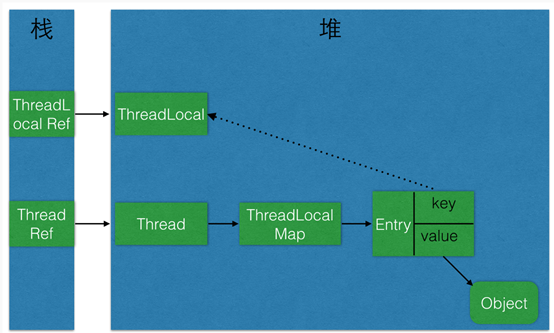前言
在我的博客spring事务源码解析中,提到了一个很关键的点:将connection绑定到当前线程来保证这个线程中的数据库操作用的是同一个connection。但是没有细致的讲到如何绑定,以及为什么这么绑定;另外也没有讲到连接池的相关问题:如何从连接池获取,如何归还连接到连接池等等。那么下面就请听我慢慢道来。
路漫漫其修远兮,吾将上下而求索!
github:https://github.com/youzhibing
码云(gitee):https://gitee.com/youzhibing
ThreadLocal
讲spring事务之前,我们先来看看ThreadLocal,它在spring事务中是占据着比较重要的地位;不管你对ThreadLocal熟悉与否,且都静下心来听我唐僧般的念叨。
先强调一点:ThreadLocal不是用来解决共享变量问题的,它与多线程的并发问题没有任何关系。
基本介绍
当使用ThreadLocal维护变量时,ThreadLocal为每个使用该变量的线程提供独立的变量副本,所以每一个线程都可以独立地改变自己的副本,而不会影响其它线程所对应的副本,如下例:
public class ThreadLocalTest { ThreadLocal<Long> longLocal = new ThreadLocal<Long>(); ThreadLocal<String> stringLocal = new ThreadLocal<String>(); public void set() { longLocal.set(1L); stringLocal.set(Thread.currentThread().getName()); } public long getLong() { return longLocal.get(); } public String getString() { return stringLocal.get(); } public static void main(String[] args) throws InterruptedException { final ThreadLocalTest test = new ThreadLocalTest(); test.set(); // 初始化ThreadLocal for (int i=0; i<10; i++) { System.out.println(test.getString() + " : " + test.getLong() + i); } Thread thread1 = new Thread(){ public void run() { test.set(); for (int i=0; i<10; i++) { System.out.println(test.getString() + " : " + test.getLong() + i); } }; }; thread1.start(); Thread thread2 = new Thread(){ public void run() { test.set(); for (int i=0; i<10; i++) { System.out.println(test.getString() + " : " + test.getLong() + i); } }; }; thread2.start(); } }
执行结果如下
 可以看到,各个线程的longLocal值与stringLocal值是相互独立的,本线程的累加操作不会影响到其他线程的值,真正达到了线程内部隔离的效果。
可以看到,各个线程的longLocal值与stringLocal值是相互独立的,本线程的累加操作不会影响到其他线程的值,真正达到了线程内部隔离的效果。
源码解读
这里我就不进行ThreadLocal的源码解析,建议大家去看我参考的博客,个人认为看那两篇博客就能对ThreadLocal有个很深地认知了。
做个重复的强调(引用[Java并发包学习七]解密ThreadLocal中的一段话):
Thread与ThreadLocal对象之间的引用关系图

看了ThreadLocal源码,不知道大家有没有一个疑惑:为什么像上图那么设计? 如果给你设计,你会怎么设计?相信大部分人会有这样的想法,我也是这样的想法: ”每个ThreadLocal类创建一个Map,然后用线程的ID作为Map的key,实例对象作为Map的value,这样就能达到各个线程的值隔离的效果“ JDK最早期的ThreadLocal就是这样设计的。(不确定是否是1.3)之后ThreadLocal的设计换了一种方式,也就是目前的方式,那有什么优势了: 1、这样设计之后每个Map的Entry数量变小了:之前是Thread的数量,现在是ThreadLocal的数量,能提高性能,据说性能的提升不是一点两点(没有亲测) 2、当Thread销毁之后对应的ThreadLocalMap也就随之销毁了,能减少内存使用量。
总结下改进后的优点
1、自动释放, 当 Thread 对象销毁后,ThreadLocalMap 对象也随之销毁,JVM 及时回收,避免了内存泄漏。如果按我们的想法:定义一个静态的map,将当前 thread(或 thread 的 ID) 作为key,需要保存的对象作为 value,put 到 map 中;如果任务完成之后,当前线程销毁了,这个静态 map 中该线程的信息不会自动回收,如果我们不手动去释放,这个 map 会随着时间的积累越来越大,最后出现内存泄漏。而一旦需要进行手动释放,那很有可能就会有漏网之鱼,这就像埋一个定时炸弹,定期爆发,而又不好排查!
2、性能提升,各线程访问的 ThreadLocalMap 是各自不同的 ThreadLocalMap,所以不需要同步,速度会快很多;而如果把所有线程要用的对象都放到一个静态 map 中的话,多线程并发访问需要进行同步(有兴趣的可以去看下 JDK1.3的实现)
Spring事务中的ThreadLocal
最常见的ThreadLocal使用场景为 用来解决数据库连接、Session管理等,那么接下来我们就看看spring事务中ThreadLocal的应用
ApplicationContext ac = new ClassPathXmlApplicationContext("applicationContext-jdbc.xml"); DaoImpl daoImpl = (DaoImpl) ac.getBean("daoImpl"); System.out.println(daoImpl.insertUser("yes", 25));
只要某个类的方法、类或者接口上有事务配置,spring就会对该类的实例生成代理。所以daoImpl是DaoImpl实例的代理实例的引用,而不是DaoImpl的实例(目标实例)的引用;当我们调用目标实例的方法时,实际调用的是代理实例对应的方法,若目标方法没有被@Transactional(或aop注解,当然这里不涉及aop)修饰,那么代理方法直接反射调用目标方法,若目标方法被@Transactional修饰,那么代理方法会先执行增强(例如判断当前线程是否存在connection,不存在则新建并绑定到当前线程等等),然后通过反射执行目标方法,最后回到代理方法执行增强(例如,事务回滚或事务提交、connection归还到连接池等等处理)。这里的绑定connection到当前线程就用到了ThreadLocal,我们来看看源码
@Override protected void doBegin(Object transaction, TransactionDefinition definition) { DataSourceTransactionObject txObject = (DataSourceTransactionObject) transaction; Connection con = null; try { if (txObject.getConnectionHolder() == null || txObject.getConnectionHolder().isSynchronizedWithTransaction()) { // 从连接池获取一个connection Connection newCon = this.dataSource.getConnection(); if (logger.isDebugEnabled()) { logger.debug("Acquired Connection [" + newCon + "] for JDBC transaction"); } // 包装newCon,并赋值到txObject,并标记是新的ConnectionHolder txObject.setConnectionHolder(new ConnectionHolder(newCon), true); } txObject.getConnectionHolder().setSynchronizedWithTransaction(true); con = txObject.getConnectionHolder().getConnection(); Integer previousIsolationLevel = DataSourceUtils.prepareConnectionForTransaction(con, definition); txObject.setPreviousIsolationLevel(previousIsolationLevel); // Switch to manual commit if necessary. This is very expensive in some JDBC drivers, // so we don't want to do it unnecessarily (for example if we've explicitly // configured the connection pool to set it already). if (con.getAutoCommit()) { txObject.setMustRestoreAutoCommit(true); if (logger.isDebugEnabled()) { logger.debug("Switching JDBC Connection [" + con + "] to manual commit"); } con.setAutoCommit(false); } txObject.getConnectionHolder().setTransactionActive(true); int timeout = determineTimeout(definition); if (timeout != TransactionDefinition.TIMEOUT_DEFAULT) { txObject.getConnectionHolder().setTimeoutInSeconds(timeout); } // 若是新的ConnectionHolder,则将它绑定到当前线程中 // Bind the session holder to the thread. if (txObject.isNewConnectionHolder()) { TransactionSynchronizationManager.bindResource(getDataSource(), txObject.getConnectionHolder()); } } catch (Throwable ex) { if (txObject.isNewConnectionHolder()) { DataSourceUtils.releaseConnection(con, this.dataSource); txObject.setConnectionHolder(null, false); } throw new CannotCreateTransactionException("Could not open JDBC Connection for transaction", ex); } }
/** * Bind the given resource for the given key to the current thread. * @param key the key to bind the value to (usually the resource factory) * @param value the value to bind (usually the active resource object) * @throws IllegalStateException if there is already a value bound to the thread * @see ResourceTransactionManager#getResourceFactory() */ public static void bindResource(Object key, Object value) throws IllegalStateException { //key:通常指资源工厂,也就是connection工厂,value:通常指活动的资源,也就是活动的ConnectionHolder // 必要时unwrap给定的连接池; 否则按原样返回给定的连接池。 Object actualKey = TransactionSynchronizationUtils.unwrapResourceIfNecessary(key); Assert.notNull(value, "Value must not be null"); Map<Object, Object> map = resources.get(); // set ThreadLocal Map if none found 如果ThreadLocal Map不存在则新建,并将其设置到resources中 // private static final ThreadLocal<Map<Object, Object>> resources = new NamedThreadLocal<Map<Object, Object>>("Transactional resources");
// 这就到了ThreadLocal流程了 if (map == null) { map = new HashMap<Object, Object>(); resources.set(map); } Object oldValue = map.put(actualKey, value); // Transparently suppress a ResourceHolder that was marked as void... if (oldValue instanceof ResourceHolder && ((ResourceHolder) oldValue).isVoid()) { oldValue = null; } if (oldValue != null) { throw new IllegalStateException("Already value [" + oldValue + "] for key [" + actualKey + "] bound to thread [" + Thread.currentThread().getName() + "]"); } if (logger.isTraceEnabled()) { logger.trace("Bound value [" + value + "] for key [" + actualKey + "] to thread [" + Thread.currentThread().getName() + "]"); } }
总结
1、ThreadLocal能解决的问题,那肯定不是共享变量(多线程并发)问题,只是看起来有些像并发;像火车票、电影票这样的真正的共享变量的问题用ThreadLocal是解决不了的,同一时间,同一趟车的同一个座位,你敢用ThreadLocal来解决吗?
2、每个Thread维护一个ThreadLocalMap映射表,这个映射表的key是ThreadLocal实例本身,value是真正需要存储的Object
3、druid连接池用的是数组来存放的connectionHolder,不是我认为的list,connectionHolder从线程中解绑后,归还到数组连接池中;connectionHolder是connection的封装
疑问
private static final ThreadLocal<Map<Object, Object>> resources = new NamedThreadLocal<Map<Object, Object>>("Transactional resources");
1、 为什么是ThreadLocal<Map<Object, Object>>,而不是ThreadLocal<ConnectionHolder>
2、 ThreadLocal<Map<Object, Object>> 中的Map的key是为什么是DataSource
望知道的朋友赐教下,评论留言或者私信都可以,谢谢!